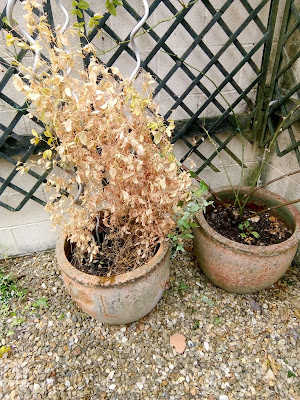Here's a cautionary tale from last summer:
"My Sweet Peas have died!" cried my friend.
"That's because you haven't watered them," I replied, sternly.
"How do you know that's why they died?" she asked.
I gave her that Look. You know the one. Eyebrows raised, lips pursed, with a little tilt of the head.
Eventually, under cross-examination, she broke down and admitted that she had forgotten all about watering these two pots, mainly because she had recently lost her regular gardener, who clearly used to water them every week.
The one containing the Sweet Peas is a write-off for this year: I advised her to cut off that mass of dead stuff and compost it, and then to water the pot in the hopes that the roots would survive - this is Perennial Sweet Pea, I should say, not the annual ones - and with luck, they'd pop up again next year, as normal.
The other pot contains a rose, carefully trained up and across the trellis, so that was a much more urgent problem.
Here is my hand, showing you that the soil within the pot has shrunk, to the point where I can get two fingers into the gap.
This demonstrates why it is no use just tipping water onto a pot, once it's this dry - all the water will simply gallop down the edge of the pot, and disappear out the bottom.
My preferred fix is to go and dig up a bucketful of earth from the garden - any rough old soil will do, as long as it's not particularly weedy - then crumble it up until it's really fine. If necessary, sieve it to get the lumps out... then trickle that sieved material down into the gap, taking care to let it fall right to the bottom of the chasm.
This is painstaking work - if you just shovel on a load of it, it will block up the top of the gap, but will leave it still wide open at the base of the gap, which defeats the objective.
So take your time, trickle it in, push it well down into the crack, using any long, thin implement which comes to hand. I used an asparagus knife, which my friend happened to have handy - that's a tool for harvesting asparagus, apparently, but it was particularly useful here as it has a long, flat blade, which was perfect for poking earth down into the San Andreas Fault, here.
Once the gap is filled, loosen the top layer of soil/compost within the pot, merging it in with the material you have just added to the sides.
Now go and get the watering can, and start watering, very gently. Pour on just a little water, keep it to the centre of the pot, and wait until it has soaked in - stand there and watch it. Repeat, and repeat: once the first couple of dollops have soaked in, the soil becomes more receptive, and you can add increasing amounts of water each time. Wait until the puddle on the surface has gone, before adding any more, and this is done to ensure that the water goes down into the centre of the pot, into the soil and the rootball, and does not gallop away down the easy route around the edges - even though we have filled in the gap with heavy garden soil, it is still an easier route than through the over-dry, rock-hard, root-filled mass within the pot, and water is very lazy: it will always take the easiest route to the lowest point.
Plus, it is very difficult to re-water dried out multi-purpose compost, as anyone
You should have time to get quite bored, but stick with it, until you reach the point where the puddle on the surface is taking quite a long time to soak away. Hooray! You may have reached the re-watered point!
Now, the trick is to keep it well watered, so give it more water every day for a week.
After the first couple of days, you might notice that the surface of the pot is starting to look a bit like the surface of the moon - glazed, with craters - so gently break up that crust (technical term: "surface pan"), which will help the water to go straight down into the middle of the pot where it is needed, and to prevent it sliding off to the outer edges.
It also helps to stop weeds getting a hold!
The above advice is for a pot which is too large to lift or move: but if you have smaller pots which have dried out, there are a couple of other techniques which can help, and I have written about there, here.
So there you go, all is not lost, even if you have forgotten to water your big pots!
Did you enjoy this article? Did you find it useful? Would you like me to answer your own, personal, gardening question? Become a Patron - just click here - and support me! Or use the Donate button for a one-off donation. If just 10% of my visitors gave me a pound a month, I'd be able to spend a lot more time answering all the questions!!


No comments:
Post a Comment
Comments take around 2 days to appear: please be patient. Excessive SPAM has forced me to restrict comments to just Members: if you have a question, you can become a Member: or you can hop over to Patreon and join me there: or you can email me direct - my email address is in the right-hand pane. Sorry about this, but honestly, the spam! I'm drowning in it!!
Note: only a member of this blog may post a comment.